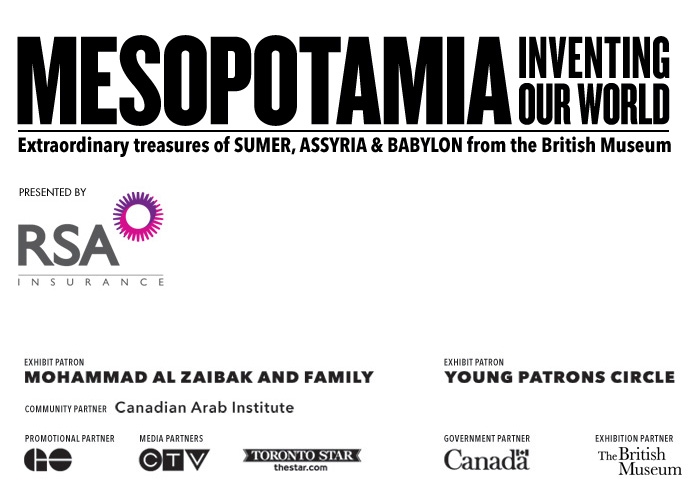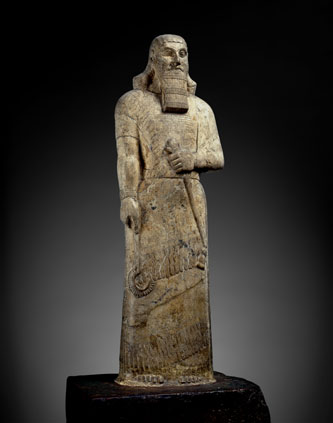 (Toronto, Ontario – June 12, 2013) The Royal Ontario Museum (ROM) is the sole Canadian venue to host Mesopotamia: Inventing Our World during its international tour. This impressive exhibition showcasing an innovative society makes its North American debut on Saturday, June 22, 2013 in the Garfield Weston Exhibition Hall on Level B2 in the Museum’s Michael Lee-Chin Crystal. On display only until Sunday, January 5, 2014, the ROM’s engagement of Mesopotamia: Inventing Our World is presented by RSA Insurance.
(Toronto, Ontario – June 12, 2013) The Royal Ontario Museum (ROM) is the sole Canadian venue to host Mesopotamia: Inventing Our World during its international tour. This impressive exhibition showcasing an innovative society makes its North American debut on Saturday, June 22, 2013 in the Garfield Weston Exhibition Hall on Level B2 in the Museum’s Michael Lee-Chin Crystal. On display only until Sunday, January 5, 2014, the ROM’s engagement of Mesopotamia: Inventing Our World is presented by RSA Insurance.
Exploring over 3,000 years of accomplishments of this ancient civilization to reveal the significance many still have on our lives today, Mesopotamia features over 170 priceless objects from the esteemed holdings of the British Museum. These artifacts, most of which have never been seen in Canada, are augmented by iconic objects from the ROM’s own renowned collections and other leading institutions, including the University of Chicago Oriental Institute Museum, University of Pennsylvania Museum of Archaeology and Anthropology (Penn Museum, Philadelphia), and Detroit Institute of Arts.
Mesopotamia is presented by the British Museum in collaboration with the ROM. The curator of the internationally touring exhibition is Sarah Collins, the British Museum’s curator for Early Mesopotamia. She says, “The British Museum is highly fortunate to have rich Mesopotamian collections as a result of British archaeological excavations undertaken in the past. As custodian of these ancient objects, it is a privilege to make them available to as wide an audience as possible – both in London and internationally. I am very happy to work with the ROM to present some of Mesopotamia’s many achievements. While it is challenging for us today to feel a connection to people of a civilization that existed thousands of years ago, I hope that exhibition visitors will discover aspects of Mesopotamian life and legacy that relate to their own lives.”
Janet Carding, the ROM’s Director and CEO states, “We are pleased to collaborate with our colleagues at the British Museum to uncover this intriguing ancient civilization. Mesopotamia has it all — longevity, noteworthy accomplishments, and a certain amount of mystery. We look forward to sharing with our visitors this dramatic story told through remarkable objects.”
Dr. Clemens Reichel, Professor of Mesopotamian Archaeology at the University of Toronto and Associate Curator for the Ancient Near East in the ROM’s Department of World Cultures, is the Museum’s expert on ancient Mesopotamia. As an experienced field archaeologist who recently returned from a trip to Iraq, he is pleased that his area of research is highlighted in the exhibition — but cautions against a narrow view of this ancient society. Dr. Reichel stresses, “Mesopotamia was a true frontrunner, with great cities of sizes not achieved by Paris or London until the Industrial Revolution; empires that controlled most of the known world of that time; and technological achievements still shaping our lives. However, Mesopotamia was also ruled by kings who were as brutal as they were brilliant, whose rise to power was as stellar as their demise was cataclysmic. With the ancient society reflecting some of mankind’s earliest ‘highs’ and ‘lows’, we are still able to learn from Mesopotamia.”
In his work Reichel is assisted by Tracy Spurrier who has joined the ROM’s exhibition planning team as assistant curator. Spurrier, who has worked on numerous archaeological projects in Egypt, Syria, and Turkey, is a Ph.D. candidate in Mesopotamian Archaeology and a specialist for the Neo-Assyrian period.
“RSA Insurance is proud to partner with the ROM as the exhibition’s presenting sponsor to make Mesopotamia accessible to all in this one-of-a-kind exhibition for Canada and North America,” says Rowan Saunders, President & CEO, RSA. “As a global insurance organization with a proud heritage insuring progress around the world for over 300 years, we’re incredibly excited to be working alongside the ROM to bring to life these amazing artifacts and we are confident this exhibition will prove to be a fascinating adventure for all.”
Background
Geographically, Mesopotamia (from the Greek “[land] between the Rivers”) encompasses present-day Iraq, north-eastern Syria, and south-eastern Turkey. Urban civilization originated in the area, accompanied by the establishment of the first cities and complex forms of social organization and economic activity. Significant developments during this period include the invention of writing, long-distance communication, trade networks, and the first empires. Sophisticated art and literature began and flourished concurrently with remarkable intellectual, spiritual, and scientific advances.
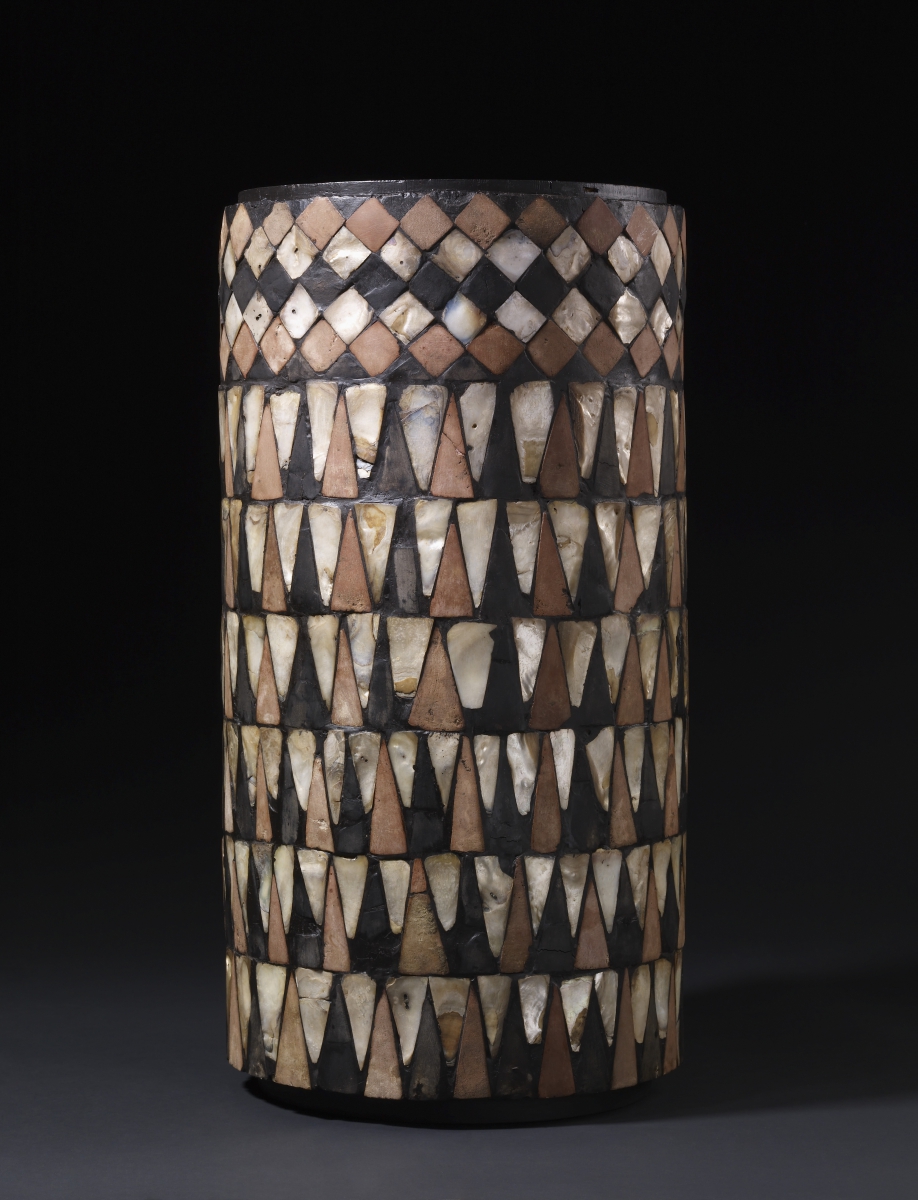
Exhibition Introduction
That the people of Mesopotamia were great innovators is established immediately on entering the exhibition. This assertion is effectively illustrated throughout the space, allowing visitors to discover their personal connections to the ancient civilization. First encountered in this Introduction area is a series of six installations or “cubes”. Interspersed throughout the exhibition and employing several media, each cube powerfully connects ancient Mesopotamian innovation to contemporary life. While Mesopotamia addresses numerous benchmarks of the society’s social and technological developments, including the Agricultural Revolution and the development of village economies, its main focus is on the emergence of cities and states in ancient Sumer (4000 - 2000 BCE); the Assyrian World Empire (1000 - 600 BCE); and the rise and fall of Babylon (600 - 540 BCE).
Sumer
During the third millennium BCE, southern Mesopotamia consisted of two main regions — Sumer, in the far south and Akkad, to the north. A common culture of shared beliefs and artistic traditions united southern Mesopotamia for much of the period between 3000 and 2000 BCE. One of the most significant advancements taking place in Mesopotamia was the emergence of the city. While large towns had evolved before 3500 BCE, there was a massive change in scale around this time. The largest city was Uruk and, by about 2600 BCE, it displayed the elements of the period’s important centres: administrative buildings, residential areas, streets, canals and, the most visible feature, cultic high terraces with temples.
True writing began in Mesopotamia, with the earliest script found on clay tablets excavated in the cities of Uruk and Susa (southwest Iran) dating to about 3300 BCE. These cuneiform tablets, several of which are included in this section, provided important administrative information, such as the tracking of quantities of malt and barley or oxen.
From 1922 to 1934, British archaeologist C. Leonard Woolley directed excavations at Ur on behalf of the British Museum and the University of Pennsylvania Museum. This city was inhabited from about 6000 BCE until the 4th century BCE and was an important political, religious, and economic centre. For a time, Ur was the capital of a state that dominated most of Mesopotamia. Some of the most spectacular discoveries were found in the Royal Cemetery, dating to the Early Dynastic Period (2600-2300 BCE). Predating the Tomb of Tutankhamun in Egypt by more than a thousand years, 16 graves were identified as “Royal Tombs” due to their construction, the abundance of grave goods, and the bodies of numerous soldiers, servants, and palace ladies who willingly (or, perhaps, unwillingly) followed their masters or mistresses into their afterlives. The jewellery and other gold objects worn by the women, including elaborate headdresses, necklaces, and bracelets made of lapis lazuli, gold, and carnelian 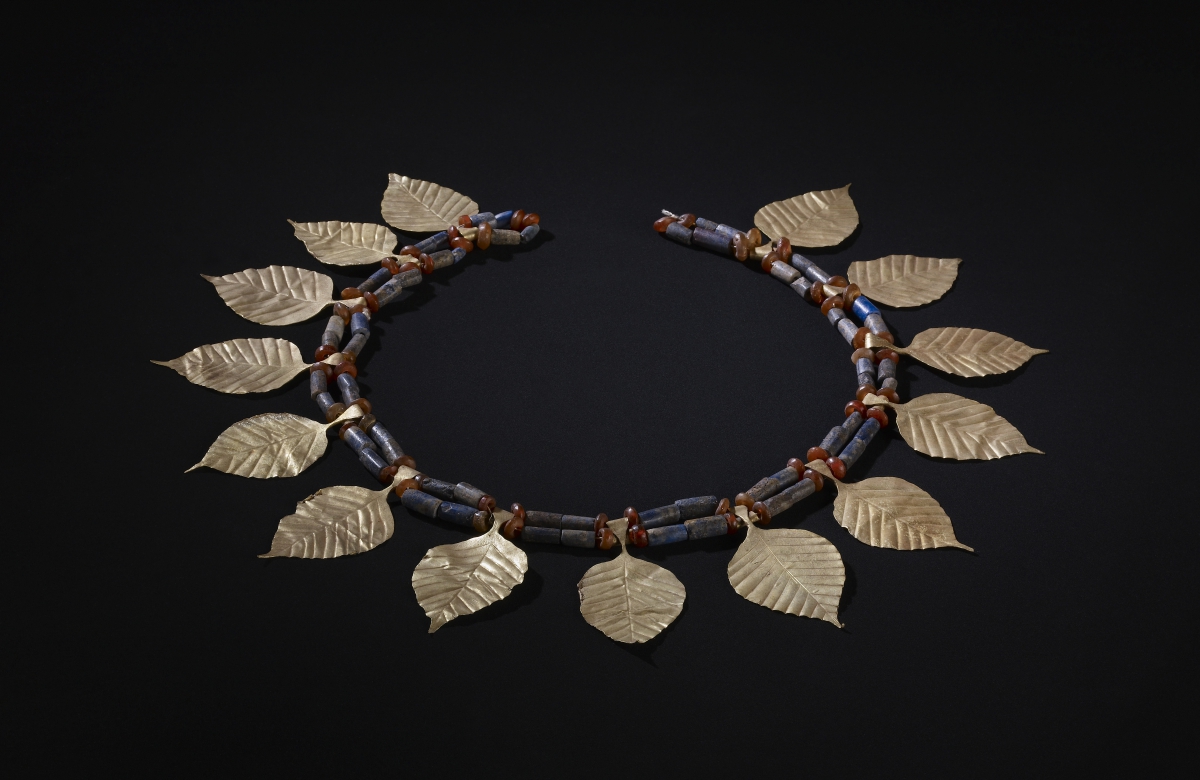 are among the exhibition’s highlights.
are among the exhibition’s highlights.
Other notable artifacts displayed in this section, exclusively seen in the ROM’s engagement, include two objects from the Royal Cemetery: the magnificent “Ram in the Thicket,” a delicate figure comprised of silver, gold foil, lapis lazuli, and shell, and the massive “Great Lyre” featuring a gold-plated bull’s head and inlays of precious materials — both on loan from the Penn Museum. The “Ram”, displayed during the first half of the exhibition’s engagement, is to be replaced by the “Lyre” for its second half. An exquisitely carved statuette of Gudea, a ruler of the city state of Lagash, is also seen in this section. On loan from the Detroit Institute of Art, it is one of the finest pieces of sculpture from the Neo-Sumerian period (2150 – 2000 BCE).
Assyria
Named for the ancient city of Ashur, Assyria was located in northern Mesopotamia on the Tigris River. For many centuries, Ashur was little more than a city-state. After 1350 BCE, however, Assyria emerged as a political and military power, becoming the dominant world power during the Neo Assyrian period (1000-612 BCE). At its height (about 660 BCE), this empire controlled an area covering Iraq, Syria, Israel, Egypt, and parts of Iran and Turkey. Several of its kings founded the new capitals at Nimrud, Khorsabad, and Nineveh. Of central importance in the administration of the Assyrian empire, in his religious role the king was the people’s direct mediator to the great gods of Assyria while politically, he was head of the state and the military. One of the most famous Assyrian kings was Ashurnasirpal II (883 - 859 BCE), represented in the exhibition by a statue made of magnesite. This figure is a rare surviving example of Assyrian sculpture in the round. Other kings represented include Tiglath-Pileser III (744-727 BCE), Sargon II (721-705 BCE), Sennacherib (704-681 BCE), and Ashurbanipal (669-627 BC).
Assyrian cities were dominated by large palaces adorned with elaborately carved stone reliefs. Artifacts from Nimrud and Nineveh’s most famed palaces dominate this section. Some of the reliefs’ scenes recount military achievements, deportations, and the punishment of rebels, while others show cultic performances involving the king. By highlighting the king’s achievements, these scenes also convey strong ideological messages: submitting to Assyria’s throne brings peace and prosperity, while rebellion results in defeat and annihilation.
Babylon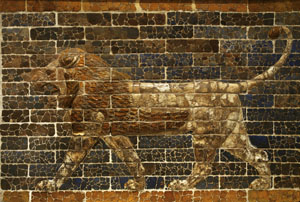
Babylon was located on the Euphrates River in what is now central Iraq. First referenced in cuneiform texts in the third millennium BCE, the city rose to prominence after 2000 BCE and controlled most of Mesopotamia by 1755 BCE. The armies of King Hammurapi, Babylon’s most famous ruler, who reigned from 1792 – 1750 BCE, united southern and central Mesopotamia under Babylonian rule. Hammurapi is best known for the collection of a set of laws named after him (Codex Hammurapi). Displayed in this section is a life-sized copy of the legendary Hammurapi Stela, on loan from the Penn Museum. The “Bismaya Head”, an elaborately carved alabaster sculpture of a ruler or tribal leader, on loan from Chicago’s Oriental Institute Museum, is another section highlight.
Following the fall of the Assyrian empire in 612 BCE, Babylonia became the dominant power of the Ancient Near East. A 3-D fly-through of Babylon, then the world’s largest city, features the city-state’s famed landmarks such as the Tower of Babel, the Hanging Gardens of Babylon, and the Ishtar Gate is an exciting component of this section. Artifacts here include the ROM’s Striding Lion Terracotta Relief, once adorning the throne room façade of the palace of King Nebuchadnezzar II (605 - 562 BCE) — where Alexander the Great later died.
Epilogue
A look at the devastation wrought by years of nationwide looting during the war in Iraq, particularly the 2003 plunder of Baghdad’s Iraq Museum and the catastrophic impact on Iraq’s archaeological and cultural heritage, is included in the exhibition. For Dr. Reichel, who coordinated the documentation of these losses in the Iraq Museum Database Project at the University of Chicago’s Oriental Institute, this presentation evokes many poignant memories. He says, “Those were among the worst days of my life. Mesopotamia, our ‘cradle of civilization’ had been trampled upon and, in some extreme cases, destroyed.”
Other Information
To complement the exhibition’s significant objects and enrich visitors’ enjoyment, the ROM incorporates several dynamic interpretive elements, delivering a distinctive experience. These include ROM-produced audio-visual installations, seven touchable reproductions of the exhibition’s artifacts, the translation of ancient text, and interactive touch-screens revealing a series of interesting facts pertaining to the ancient society. A children’s activity corner offers hands-on activities for younger exhibition visitors.
Enlightening public programming takes place through the exhibition's engagement. Friday Night Live (FNL) is now in its third successful season. The city’s singular social destination calls on Mesopotamia for its June 21st edition, the season’s finale, as it celebrates Middle Eastern culture including live performances by Juno-nominated composer/DJ Adham Shaikh and multi award-winning and JUNO-nominated Jaffa Road. That the ancient civilization has been credited with inventing beer makes the exhibition a fitting FNL theme! A lecture series, including a talk delivered in French, hosts internationally respected scholars addressing numerous exhibition concepts. A symposium, scheduled for October 19 and 20, features renowned speakers engaging in lively dialogue around the issues of looting in Iraq and the long-lasting impact on its cultural heritage. The symposium’s key note event is a discussion between Colonel Matthew Bogdanos, a US Marine Officer and author of Thieves of Baghdad (2005) and McGuire Gibson, Professor at the University of Chicago’s Oriental Institute and one of the world's leading authorities on ancient Mesopotamia. Interactive and creative exhibition-themed weekend activities ensure an enjoyable experience for the whole family. Families can also expect exciting ROM for the Holidays programming. Additional details on all programs are to be announced.
Continuing its award-winning commitment to accessibility for all visitors, the ROM has developed an Accessibility Strategy outlining its promise to remove barriers to participation for visitors with disabilities. Throughout the exhibition, several enhancements will be encountered including touchable objects, audio described tour and captioned videos. For specific questions or concerns, call 416.586.8000 prior to visiting. For those who are deaf, deafened or hard of hearing, Bell Relay Service can be reached by dialing 711 or 1.800.855.0511.
ROM Members already know that the best way to experience the ROM is through Membership. The Mesopotamia Member Preview takes place on Friday, June 21. For additional information or to purchase a membership, visit www.rom.on.ca/members or call 416.586.5700. Timed exhibition tickets are available at 30-minute intervals. Groups of 20 or more may email groupsales@rom.on.ca or call ROM Group Sales at 416.586.5801 (ext 2) for information on special rates, private lectures, guided tours and themed menus. Ontario school groups should contact ROM Education at www.rom.on.ca/schools or call 416.586.5801 (ext 1) for information on school visits. Public exhibition tours are offered daily for an additional cost of $5, with French tours scheduled weekly.
Visitors may feel like international travelers on stepping into the exhibition’s dedicated shop or the ROM Boutique on Level 1. Evoking the ambiance of a Middle Eastern bazaar, the shops’ distinct exhibition-themed wares include jewellery, home décor, stationery, beauty items, fashion apparel, and reproductions of some of the exhibition’s most dramatic objects. Also available is an array of books, including an exhibition souvenir guide, on sale for just $5. Published in both English and French, and filled with fascinating text and gorgeous full-colour images, the guide is also on sale at the ROM’s admissions kiosks and in select stores. Weary world travelers can pause and refresh with Middle Eastern fare in DRUXY's ROM Cafe.
Visit www.rom.on.ca/meso for full exhibition details and follow the ROM via Facebook, YouTube, the ROM blog, and Twitter (@ROMToronto, #ROMMeso) for regular updates. The ROM’s e-newsletter is free and can be subscribed at www.rom.on.ca/en/newsletter.
Mesopotamia arrives at the ROM directly from the Hong Kong Museum of History (January 30 to May 13, 2013) following a successful engagement in 2012 at Australia’s Melbourne Museum.
The engagement of Mesopotamia is complemented by Catastrophe! Ten Years Later: the Looting and Destruction of Iraq’s Past. Originally developed by the Oriental Institute of the University of Chicago in 2008, the display looks at the devastation of Iraq’s cultural heritage during, and following, 2003’s Iraq War. Now, marking the tenth anniversary of the looting of Baghdad’s Iraq Museum and the destruction of numerous other sites, the award-winning, internationally touring display has been updated. The revised presentation makes its debut at the ROM from June 22, 2013 to January 5, 2014.
ROM Ancient Cultures
Mesopotamia is a stunning introduction to one of the ROM’s new Centres of Discovery. ROM Ancient Cultures seeks to be recognized globally as an essential destination for making sense of how past societies inform our lives and help us plan for the future. Assembling collections and expertise from the ROM Department of World Cultures, in partnership with the ROM’s Programs, Education, volunteers, Friends groups and Museum users, this Centre will provide a focal point for research, programs and activities related to Ancient Cultures and Archaeology at the ROM and in the community. Follow @ROMAncient.
Mesopotamia is presented by the British Museum in collaboration with the Royal Ontario Museum.
Mesopotamia: Inventing Our World at the ROM from June 22, 2013 to January 5, 2014
